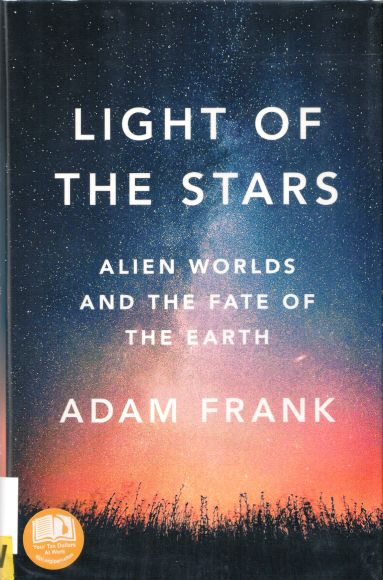

| LIGHT OF THE STARS Alien Worlds and the Fate of the Earth Adam Frank New York: W. W. Norton and Company, June 2018 |
Rating: 5.0 High |
|||
| ISBN-13 978-0-393-60901-1 | ||||
| ISBN-10 0-393-60901-4 | 262pp. | HC/BWI | $26.95 | |
Following in the tradition of Isaac Asimov, Carl Sagan, Chris Impey, Carl Stern & David Grinspoon, and many others, astrophysics professor Adam Frank has penned a book of insight, one which illuminates and inspires. Its focus is on climate change, but not really; on extraterrestrial civilizations, but not really; and on the immaturity of human civilization. The reason is that these three subjects are closely tied together by what's known as the Fermi Paradox — the fact that, though life seems likely to be common on other planets, we on Earth have never seen any sign of intelligent life elsewhere.
Despite the flying-saucer craze of the 1950s and 1960s, there is no confirmed sighting of an alien spaceship in our skies. Nor, even though our capacity to observe nearby space has grown vastly greater, have we any proof of derelict alien spaceships drifting through our system.1 Neither have any artifacts been found on the surface of any planet or moon visited by robot probes, much less the devices dear to fiction writers: no black monolith on the Moon, no "Great Volume of Knowledge" on Mars, no giant machines in the rings of Saturn. And the evidence most avidly sought, radio or laser signals from planets around other stars, has eluded sixty years of searching.2
All of which leads us to wonder whether we are alone in the cosmos — and if so, why?
In the summer of 1961, as discussion of SETI was getting under way, Frank Drake devised a probabilistic way to estimate the number of intelligent, communicative civilizations in the Milky Way, our home galaxy of some 400 billion stars. He multiplied seven factors together to yield a final tally. The last factor is the most important: it estimates the lifetime of a typical civilization. The other factors of the Drake Equation, which depend on physics or biology, operate over millions or billions of years. If civilizations typically don't last long, those other factors are rendered moot. Millions of technical races might spring to life in the Milky Way, blossom like flowers, and soon gutter out like brief candle flames in windstorms of their own making.
Our own world faces the crisis brought by nuclear weapons, and has avoided that storm — but only so far, and only with great luck. Now, it also faces the crisis brought by global warming: a storm it is, to be kind, handling poorly. Adam Frank's first contribution is to put this poor performance in perspective. His second is to explore it in starkly quantitative terms. He and his colleagues undertook A Theoretical Archaeology of Exo-Civilizations — a way to model the interaction of civilizations' energy use with the carrying capacity of their ecosystems.
"But if we are already creating theoretical models of biosphere-harboring planets, what keeps us from carrying out the same process for worlds harboring civilizations? If we ask the right kind of questions, nothing stands in our way; we can get started now. By uniting our understanding of planets with population ecology—in the spirit of Volterra and those who followed—we can take a first stab at exploring the coupled trajectories of civilizations and their planets as generic cosmic phenomena. It's a project that might be called a theoretical archaeology of exo-civilizations. Anything we do concerning exo-civilizations will have to be theoretical. This is true not only because we don't have data, but also because our method will start from basic ideas about life and environments, as Voltera did in developing his predator-prey model. We want to let physics, chemistry, and population ecology guide us in unpacking the possible histories of exo-civilizations. Our goal with this theoretical archaeology of exo-civilizations is to see what could have happened to them, so that we can get a better handle on what might happen to us. – Page 185 |
They have made thousands of runs to model how a civilization, reduced to essentials such as how it uses the various energy options available to it, how it switches from "dirty" options to cleaner ones, and how these choices affect its population as time progresses.
The outlook is grim.
"In many of the models, we saw as much as 70 percent of the population die before a steady state was reached. – Page 196 |
There were, however, models that showed civilizations winning through to long-term sustainability — even if they were in the minority. And though these models are simplistic, they will grow in sophistication. Clearly they can make a contribution to the debate over how to respond to climate change.
The book itself is very well written, detailed and accurate, but with a certain flair that makes it enjoyable. The text covers a lot of history, and is supplemented by sixteen black-and-white photographs and six graphs. A good index and extensive endnotes are provided. It does have some annoying factual errors, but I won't penalize it for that. I give this top marks and rate it a keeper.

 To contact Chris Winter, send email to this address.
To contact Chris Winter, send email to this address.